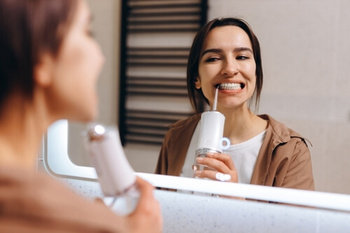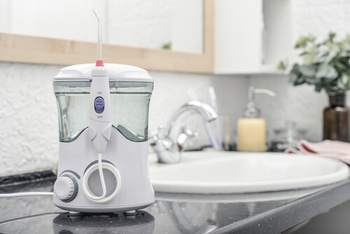Navigating oral hygiene challenges with dental braces can often feel like an intricate dance. Despite the detailed brushing and fiddling with dental floss, food particles still find a way to hide in the nooks and crannies of your orthodontic hardware. So, what’s the solution to this often frustrating problem? Enter the water flosser—a revolutionary device that promises to improve gum health and make the tedious process of flossing with braces substantially easier.
What is a Water Flosser?
A water flosser, also widely referred to as an oral irrigator, is an innovative device designed to elevate your oral hygiene routine to the next level. While traditional methods like dental floss have been effective for many years, the water flosser offers a more sophisticated and comprehensive way to clean your teeth, especially when dealing with dental braces.
The Science Behind It
The science underpinning the water flosser is rather straightforward but quite ingenious. The device utilises a motor and pump to produce a stream of pressurised water. When aimed between the teeth and along the gum line, this water jet is remarkably effective in dislodging plaque and food particles that are often left behind, even after meticulous brushing and conventional flossing.
Anatomy of a Water Flosser
So, what makes up a water flosser? A typical unit comprises the following key components:
- Reservoir: This is the tank where you fill the water used for flossing. Some advanced models allow for mouthwash to enhance the cleaning experience.
- Motor and Pump: These mechanical elements propel the water through the flosser tip.
- Flosser Tip: This is the part that you hold and aim between your teeth. Various tips are available, such as standard jet tips, orthodontic tips, and even tips designed for plaque removal.
- Control Panel: This usually features different settings that allow you to adjust water pressure, switch the unit on or off, and sometimes even control the water temperature.
- Hose (for countertop models): This flexible tube connects the flosser tip to the main unit. Cordless models do not have a hose, as the motor and reservoir are built into the handheld device.
Types of Water Flossers
Water flossers can be broadly categorised into two types:
- Countertop Water Flosser: These are generally more robust and have various features. They usually offer higher water pressures and larger reservoirs, which makes them ideal for extended flossing sessions. Different brands offer a range of countertop models with varying functionalities tailored to individual needs.
- Cordless Water Flosser: Designed for convenience and portability, cordless models like are battery-operated or rechargeable. They are perfect for people who travel frequently or have limited bathroom counter space. However, they may offer fewer pressure settings and have a smaller water reservoir.
Clinical Validation
Water flossers have been rigorously evaluated in various clinical settings. The evidence is compelling: consistent use of a water flosser can improve gum health, reduce inflammation, and serve as an effective tool in the prevention of gum disease. This is particularly relevant for individuals with dental braces, as the hardware often complicates traditional flossing methods.
Why Use a Water Flosser with Dental Braces?
Dental braces, while a critical and effective solution for addressing various orthodontic issues, present unique challenges when it comes to maintaining oral health. The design— wires, brackets, and bands—creates an intricate maze that can trap food particles and harbour plaque. Though indispensable in a typical oral hygiene routine, traditional dental floss often falls short when navigating this labyrinthine configuration.
The Limitations of Traditional Floss

Dental professionals have long vouched for the efficacy of traditional dental floss; however, its shortcomings become evident when used with dental braces. For one, threading a piece of string floss around each wire and bracket is a painstakingly slow process. The effort required to clean around braces effectively can lead to inconsistent flossing habits, thereby putting gum health at risk.
Furthermore, the physical design of dental braces can limit the reach of string floss. Areas behind and underarms, brackets, and tight spaces between teeth are often difficult to access. As a result, plaque and food particles can accumulate, posing an increased risk of gum disease and dental decay.
Why Water Flossers are the Game Changer
In contrast, using a water flosser for braces offers a host of advantages that make it a powerful addition to your oral care regimen:
- Efficiency: The design of the water flosser allows for a stream of water to be precisely directed between teeth and around braces, thoroughly cleaning these challenging areas in a fraction of the time it would take using traditional floss.
- Effectiveness: Studies have shown that water flossers can be up to 51% more effective in reducing gum disease when compared to dental floss, especially in people undergoing orthodontic treatment. This is crucial for maintaining gum health throughout the period you’ll be wearing braces.
- Ease of Use: The user-friendly design makes water flossing far less cumbersome than string floss. This can be particularly beneficial for children and teenagers who may be new to oral hygiene and find traditional methods intimidating or tedious.
- Versatility: With various pressure settings and a range of interchangeable tips, water flossers can be customised to suit individual needs. Specialised orthodontic tips are designed to flush out food particles and plaque from around the brackets and wires, making them an excellent choice for those with dental braces.
- Improved Oral Health: Consistent water flosser use contributes to better oral health. It not only dislodges plaque and food particles but also improves blood circulation in the gums, enhancing gum health.
Professional Recommendations
Many dentists now recommend incorporating a water flosser into your oral hygiene routine when wearing dental braces.
How Does it Compare to Traditional Floss?
Regarding dental care, few topics are as hotly debated as the efficacy of water flossers compared to traditional floss. Each has its merits and demerits, but how they stack up, particularly when faced with the added complexity of dental braces, is worth exploring in detail.
Methodology of Cleaning
Traditional Floss: Flossing with a string involves manually running a thin piece of floss between teeth and around the gum line. This mechanical action removes plaque and food particles but requires significant manual dexterity.
Water Flosser: Water flossing employs a different mechanism. A pressurised stream is used to flush out plaque and food particles. The water can be aimed around the teeth, along the gum line, and into tight spaces, often unreachable with traditional floss.
Effectiveness in Plaque Removal
Traditional Floss: While highly effective when used correctly, the efficacy of string floss is often compromised by incorrect technique, inconsistent flossing, or difficulty in accessing hard-to-reach areas, especially around dental braces.
Water Flosser: In contrast, water flossers are exceptionally effective in dislodging plaque and food particles, reducing gingivitis, and improving gum health, even in orthodontic patients. The pressurised water can reach areas difficult to access with string floss, especially around the brackets and wires of dental braces.
Usability and Accessibility
Traditional Floss: String floss is cheap, widely available, and highly portable. However, it can be challenging to use effectively, especially for those with limited dexterity or dental braces, dental implants, or other dental work.
Water Flosser: Water flossers, especially countertop models, are generally more expensive and require electrical power. However, they are significantly easier to use, particularly for those undergoing orthodontic treatment, older adults, and people with dexterity issues.
Risk of Gum Damage
Traditional Floss: If not done properly, flossing can sometimes cause minor damage to the gums, leading to bleeding and discomfort.
Water Flosser: The risk of damaging your gums is substantially lower with water flossing. The lukewarm water provides a gentle yet effective cleaning action and is less abrasive than string floss.
Features and Customisation
Traditional Floss: Apart from the various thicknesses and materials, there’s not much in the way of customisation when it comes to traditional floss.
Water Flosser: One of the standout features of water flossers is their customisability. Many models offer multiple pressure settings, various tips—including orthodontic tips for braces—and even the option for adding mouthwash to the reservoir for an enhanced cleaning experience.
Environmental Impact
Traditional Floss: Most floss is non-biodegradable and contributes to waste. Some sustainable options are available but are not as widely used.
Water Flosser: While it may consume electricity, it is generally more eco-friendly as it is a long-lasting device with no need for disposable parts except for the occasional replacement tip.
Key Features to Look For

Selecting a water flosser may seem straightforward, but the task becomes a bit more complex when you factor in the specific requirements imposed by dental braces. It’s not just about picking a water flosser; it’s about choosing one that can effortlessly manoeuvre around the brackets, wires, and bands of your orthodontic treatment. Below are some of the essential features you should be on the lookout for:
Pressure Settings
A water flosser with adjustable pressure settings is a must. Everyone’s oral sensitivity varies, and when you have dental braces, this is even more critical. Adjustable settings allow you to tailor the water pressure to your comfort level, ensuring a pleasant yet effective cleaning experience.
Types of Tips
Water flossers usually come with various interchangeable tips, and some are specifically designed for use with dental braces. For instance, orthodontic tips come with tapered bristles that can get in and around wires and brackets, providing an extra layer of cleaning efficacy. This is a crucial feature for anyone undergoing orthodontic treatment.
Reservoir Capacity
The reservoir is where the water or mouthwash is stored before it’s propelled through the flosser tip. If you’re using the water flosser for braces, you might need more time than usual to clean the hardware thoroughly. Therefore, opt for a model with a larger reservoir to ensure you don’t have to refill it midway through your flossing session.
Portability and Design
If you travel frequently, consider investing in a cordless water flosser. These battery-operated or rechargeable models are more portable than their countertop counterparts. However, if you prefer the robustness and additional features often come with countertop models, ensure sufficient space on your bathroom counter to accommodate it.
Battery Life (For Cordless Models)
For cordless models, battery life is an essential factor. The last thing you want is for your water flosser to die on you midway through a cleaning session. Look for models with long-lasting batteries or quick recharge features.
Water Temperature Control
While not a standard feature, some high-end models offer water temperature control. For those sensitive to cold water, lukewarm water can make the flossing experience much more comfortable.
Noise Level
Water flossers are mechanical devices, and as such, they generate noise. If you’re sensitive to noise or plan to use your device when others might be sleeping, look for models advertised as quiet during operation.
Warranty and Customer Support
Last but certainly not least, a good warranty and strong customer support indicate a company’s confidence in its product. This is not just about getting value for your money; it’s also about ensuring that you have a reliable avenue for assistance should you encounter any issues with your device.
Step-by-Step Guide to Water Flossing with Braces
Fill the Reservoir: Use lukewarm water for a more comfortable experience.
Choose the Right Tip: Orthodontic tips are most effective for dental braces.
Adjust the Pressure: Start with a lower setting and increase as you become comfortable.
Lean Over the Sink: To avoid a mess, lean over the sink during water flossing.
Start Flossing: Aim the tip at a 90-degree angle to the gum line and move along each tooth’s surface, paying special attention to the areas around the brackets and wires.
Empty the Reservoir: Once done, empty any remaining water to prevent bacterial growth.
Additional Tips for Maximum Effectiveness
Combine with Traditional Floss: Use a water flosser in conjunction with traditional floss for best results. The string floss helps dislodge bigger food particles, and the water flosser sweeps them away.
Add Mouthwash: To enhance oral health, consider adding a small amount to the water reservoir.
Frequency: Using a water flosser at least once a day, preferably before bedtime, is recommended to improve gum health substantially.
Consult Your Dentist: Before starting any new oral hygiene routine during orthodontic treatment, always consult your healthcare provider.
Comparison of Our Water Flosser With Waterpik Water Flosser
When assessing the landscape of oral hygiene products, the Denfinity Oral Care Set distinctly positions itself as an integrated solution, harmoniously merging Water Flosser and Sonic Toothbrush technologies. This unified approach ensures a thorough and balanced oral care routine, something singular devices like Waterpik water flossers can’t provide, emphasising the effectiveness and comprehensive care Denfinity brings.
Convenience and Space Efficiency
The Denfinity set is a paradigm of convenience and space efficiency. It consolidates the need for multiple devices, saving precious counter space and power outlets, a feature especially appealing to those with a penchant for minimalism and orderliness. In contrast, acquiring a separate Waterpik cordless flosser and a sonic toothbrush can contribute to clutter and inconvenience due to multiple devices.

Proven Effectiveness and Superior Performance
Denfinity guarantees healthier gums in 14 days, showcasing its commitment to quick and tangible results. Clinically, it’s up to 50% more effective than traditional dental floss and has an 80% higher effectiveness rate than Sonicare® Air Floss. Denfinity is three times as effective as dental floss, particularly around braces, outperforming the plaque removal capabilities of Waterpik water flossers.
Essential for Diverse Dental Needs
Denfinity’s Oral Care Set is the go-to choice for those with varied dental needs, including individuals with implants, crowns, bridges, and veneers. Click here. It addresses the nuances of diverse dental conditions and structures, ensuring optimal care and maintenance. The adaptability and versatility of Denfinity’s Oral Care Set position it as a preferable choice over Waterpik for people with specific dental conditions and needs.
While Waterpik has been a reliable choice for many in their oral care journey, the Denfinity Oral Care Set clearly emerges as the superior choice. Its integrated approach, space efficiency, superior performance, and adaptability to varied dental needs make it the ultimate companion for those seeking comprehensive and effective oral care. In the realm of water flossers, Denfinity undoubtedly stands as the best.
Conclusion
Navigating the complexities of orthodontic treatment can be challenging, particularly when dealing with dental braces. Traditional floss can often fall short of offering a comprehensive cleaning experience, especially around the intricate structures of orthodontic treatment. This is where the modern marvel of water flossers comes in. Water flossers are gradually becoming indispensable in maintaining optimal oral health, offering versatility, efficacy, and ease of use.
Ready to Take the Next Step?
If you have more questions about water flossers, dental braces, or general oral health, don’t hesitate to contact the Infinity Dental Care experts. Your smile is an investment; we’re here to ensure you make the most of it. Call us today at (02) 9159 6237 to schedule a consultation or to discuss the best oral care practices tailored to your needs.
References:
https://www.nytimes.com/wirecutter/reviews/best-water-flossers/
https://www.oralb.co.uk/en-gb/oral-health/why-oral-b/why-floss/what-is-a-water-flosser

